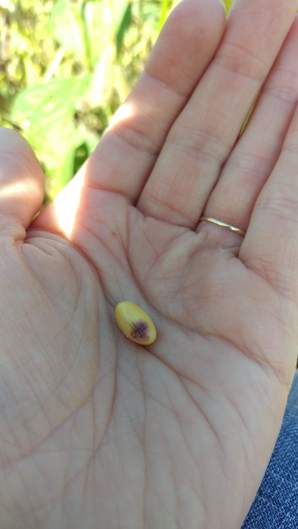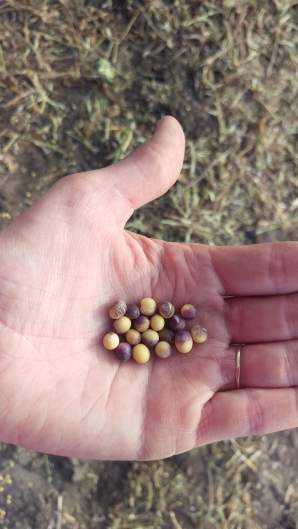Upcoming events:
Sept. 24: Beef Quality Assurance, 5:00-7:00 p.m. Jefferson County 4-H Building, RSVP: kristen.ulmer@unl.edu
Sept. 25: Beef Quality Assurance, 2:00-4:00 p.m. Tecumseh Community Building, RSVP: kristen.ulmer@unl.edu
Sept. 25: Beef Quality Assurance, 7:00-9:00 p.m. Nebraska Extension in Saunders County Office, RSVP: kristen.ulmer@unl.edu
It was great seeing harvest progressing this week and a challenge to stay ahead of harvest notes with on-farm research plots coming out! With the craziness of this week, I didn’t get a CropWatch article written on rapid drydown of corn and soybean. However, there’s a really good resource on this topic from Bob Nielsen at Purdue and you can find it here: https://www.agry.purdue.edu/ext/corn/news/timeless/graindrying.html.
Purple Seed Stain: I meant to write about this last week as I was finding it in fields pre-harvest. So far I’ve seen or heard it to be mainly in mid-group 2 bean varieties. During early to late seed fill, you may have noticed some reddish/bronzing color on soybean leaves. This can be due to Cercospora Blight in soybean. The disease is also characterized by leaf drop while petioles remain. However, while the same fungus causes both Cercospora Blight and Purple Seed Stain, there’s no clear association as to how much seed stain will be observed if the leaf blight also occurred. The fungus, Cercospora kikuchii, is related to the fungi causing gray leaf spot in corn and frogeye leaf spot in soybean. Thus, humidity, leaf wetness, rain, and the cloudy conditions experienced in August and early September allowed for Cercospora species in general to increase late this past year. Purple seed stain symptoms appear as pink or purple specks or splotches occurring on the soybean seed. I haven’t heard of enough seed symptoms in loads to affect docking, but it could happen if fields were affected severely enough. There are resistant varieties to Cercopsora blight but no known resistance for purple seed stain. The fungus is seed transmitted, so seed infected with purple seed stain should be treated with a fungicide seed treatment if used for seed.
Soybean problems: Diaporthe/Phomopsis complex may be the explanation for those of you who had patches of fields turn brown/gray and die early with pods appearing flat and seeds shrunken/moldy. That’s not to say there hasn’t been other problems such as anthracnose, phytophthora, and some sudden death syndrome as well. Keeping a few stems and sending them into a diagnostic lab is the best way to tell. The Diaporthe/Phomopsis complex includes a number of diseases including Pod and Stem Blight, Stem Canker, and Phomopsis Seed Decay. Infections can occur at any time on the plants, but infection increases with warm/humid weather close to maturity (as we experienced this year), wet weather during harvest increases pod infection, and high winds/hail/and other events that allow entry-way for pathogens into the plant.
Wheat: It’s been great to receive questions the past few weeks on planting wheat! For those seeking resources, my colleague Nathan Mueller in Dodge County has dedicated a section of his web page (http://croptechcafe.org/winterwheat/) to growing wheat in Eastern NE including an email listserv that shares new information. There was also an edition of UNL CropWatch devoted to winter wheat information here: https://cropwatch.unl.edu/2018/august-31-2018. Key points I emphasize for wheat include: killing out volunteer wheat at least 2 weeks prior to planting new wheat, treating wheat with fungicide seed treatment, and ensuring proper seeding depth by ensuring enough weight on the seeder particularly when no-till planting into residue.
I realize the economics for one year don’t look great for wheat. However, looking at the bigger picture, what is that wheat crop allowing in adding additional time for a forage or cover crop, breaking pest cycles, and giving you an additional 2-3 months time before needing to apply herbicides for weeds like palmer amaranth? And, what is it providing in residue for the following year to help reduce the number of weeds you see? The following comes from an article Nathan wrote on his website. There’s many benefits for adding wheat in rotation and perhaps it’s something you wish to consider this year! “Adding wheat to your eastern Nebraska cropping system can offer many other benefits:
- Additional revenue in utilizing or selling the straw
- Added profit by growing more late summer and early fall forage crops
- Ability to more effectively incorporate cover crops
- Selling grain at elevators with good basis, for example wheat often is 10 cents above futures in Fremont
- Reducing herbicide cost for troublesome weeds like marestail, waterhemp, and Palmer amaranth, in short, disrupting weed cycles
- Higher soybean yields in 3-yr rotation due to reduction in pest pressure
- Potential reduction in yield loss from compaction by not driving on wetter soils during manure application in the fall and spring.
- Opportunity to contract with feedlots for manure application in the summer months
- Reduce soil erosion and nutrient loss during high risk months of April-May-June.
- Improved soil health, soil structure, and infiltration may provide long-term profitability
- Reduced labor cost through better distribution of workload on the farm.
- Possible higher cost share for conservation work during the months of July, August, September.
- Possible higher USDA CSP ranking score for planting winter wheat resulting in additional revenue
- During periods of dry years, dryland corn yield boost the following year.
- Demonstrated local success at obtaining high yields (100 bushel/ac)”
Early Leaf Drop: The rain and humidity increased our fungal diseases in shade trees and we’re seeing early leaf drop in some species as a result. In particular, I’ve received calls and looked at ash, maples, lindens, crabapples, and flowering pears. Early leaf drop also may be due to the environmental swings we experienced this year from rain and cooler temps to hot, dry conditions. We don’t recommend homeowners do anything about this and it shouldn’t impact the long-term health of the tree.




































